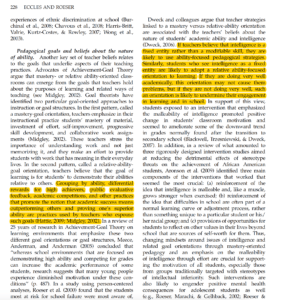“Much of the work related to this phenomenon in the last decade has focused on differential treatment based on race or ethnic group and has relied on students’ perceptions of differential treatment. Researchers interested in the relatively poor academic performance of adolescents from stigmatized groups have suggested that discrimination or teachers’ differential treatment of students based on ethnicity, race or gender may play a role” (Eccles and Roeser, 227).
This passage intrigued me because this effect is something I’ve never thought much about before. I recall throughout middle and high school that I thought girls were stereotypically better at reading or writing whereas perhaps I viewed the boys as better at math or science. I’d never thought about the impact of teachers’ stereotypes on ethnicity or race in particular. It makes sense that teachers’ expectations of different groups of people would affect their performance in school. This passage also made me reflect on how I may have been affected by teachers’ biases when I was a kid, as well as biases I may have had toward other students. Perhaps I unfairly prejudged my peers’ abilities. I wonder how much of it I could have picked up from my teachers, friends, or family.

